Crab cakes are an American classic ? a dish born of plenty, and served simply, preferably with an ice-cold beer, on a deck overlooking Chesapeake Bay. Sure, they make them elsewhere ? spiked with bird's eye chilli and lime juice in Thailand; served with cold mashed potato in Peru - but nowhere are they more revered than on the east cost of the US, where they're honoured with festivals, cook-offs and, inevitably, competitive eating events.
Crab cakes are a particular speciality of Maryland, as eager Wire-watchers will testify ? McNulty even uses a box as a bribe in season one of the Baltimore-based drama. Interestingly, the Oxford Encyclopedia of Food and Drink in America suggests that the recipe dates back to the earliest European settlers, who, because of the labour-intensive nature of harvesting crab, would stretch the meagre results by using the meat in "small fried cakes".
 Saveur recipe crab cakes. Photograph: Felicity Cloake
Saveur recipe crab cakes. Photograph: Felicity Cloake Such frugal offerings are unlikely to pass muster with today's Americans however ? they rate their crab cakes on the quantity of crustacean. As Tom Douglas, the author of I Love Crab Cakes warns, "beware the poor fellow who gets dinged for using 'too much filler,' a common reference to too many crumbs in your cake, for he shall hang his head in shame".
In Britain we may not enjoy the same abundance of seafood, but we do produce some great crab at this time of year, albeit of a rather more diminutive nature than they might be used to across the pond. Such a delicacy doesn't deserve to be buried in melted cheese, or overwhelmed with spices: the great thing about the American crab cake is that it really is more crab than cake. So, as our own season reaches its glut, it's time to crack open the claws and get crabbing.
The crab
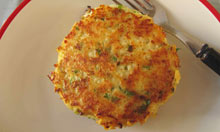 James Beard recipe crab cake. Photograph: Felicity Cloake
James Beard recipe crab cake. Photograph: Felicity Cloake In the UK, we don't see much of the blue crab, the American connoisseur's crustacean of choice ? indeed, it's only been sighted twice in British waters. It is available online, but it seemed to make more sense to use a native variety. However, the fresh picked crab I deploy first is mostly shredded too finely to work well in a fish cake of the American sort, which always call for "jumbo lump crab" in pieces apparently the size of a gobstopper. This just falls apart in the pan.
If you can't find white crab meat in the necessary lumps, you'll have to do the picking yourself: get the biggest beast you can find, and work delicately, concentrating your efforts on claw meat ? there's a good guide here (pdf). If you're unable to find fresh crab, I have also experimented with (imported, sadly) tinned lump crab meat which, although the flavour is inevitably not so good, makes a pretty passable cake.
Playing a binder
 Old Bay recipe crab cake. Photograph: Felicity Cloake
Old Bay recipe crab cake. Photograph: Felicity Cloake As we've established, a properly proud American crab cake relies on there being as little of this as possible. The majority of recipes seem to fall into two distinct camps. The first, like the legendary food writer James Beard, chef and sustainable seafood champion Rick Moonen, Saveur magazine, and the Old Bay seasoning company, who have featured a crab cake recipe on their packaging for as long as anyone can remember, opt for something wheat based ? breadcrumbs, in most cases, but there's also the option of crushed crackers, as in Saveur's, collected from Nick's Inner Harbor Seafood in Baltimore, or flour, as in Mark Bittman's cakes for the New York Times. I find James Beard's breadcrumb-based recipe, moistened with egg and a little cream, has the best texture of the lot ? the crumbs give a lighter cake than the flour or crackers, which seem to give a slightly soggy effect.
The second group, which includes a recipe from swanky New York grocers Dean & Deluca's cookbook, relies only on liquid binders ? mayonnaise and sour cream in their case. I find them rather wet in texture, and the flavour of the mayonnaise too assertive ? the great benefit of bread and flour is that they blend into the background.
Some recipes hedge their bets: the Baltimore crab-flake cakes from 1932's National Cookbook start off with a bechamel, and Rick Moonen makes a sort of cooked mayonnaise base with hot oil and egg yolk, and allows this to cool before stirring in the crab and breadcrumbs. The bechamel isn't quite stiff enough to hold the cakes together well, and Rick's cakes, although fine texturally, are a bit too rich for my taste. The predominant flavour should be that of crab, rather than fat, so I'm sticking with Beard's breadcrumbs, and cutting out his double cream: an egg will do the trick just as well.
Flavourings
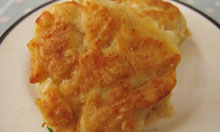 Mark Bittman recipe crab cake. Photograph: Felicity Cloake
Mark Bittman recipe crab cake. Photograph: Felicity Cloake Mustard is a very popular choice in crabcakes ? the only recipe I find which doesn't include it is the oldest, which adds Worcestershire sauce instead. Wholegrain, as in the Dean & Deluca recipe, looks pretty as it studs the cakes with seeds, but I think dry powder, as used by James Beard, is better than this or the Dijon in Rick Moonen and Mark Bittman's recipes ? it adds heat without the vinegary tanginess of prepared mustard.
I can't taste the yellow mustard in the Old Bay recipe, in fact, all I can taste is this secret blend of herbs and spices, which was developed in Baltimore in the 1940s as a seasoning for the region's abundant seafood. Its packaging will admit only to celery salt, red and black pepper, and paprika, but I can also pick up nutmeg which, although I find the seasoning itself too pungent, works beautifully with the crab.
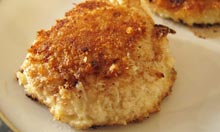 National Cookbook recipe crab cakes. Photograph: Felicity Cloake
National Cookbook recipe crab cakes. Photograph: Felicity Cloake I reject both mayonnaise and Worcestershire sauce, which appear in a number of recipes including the Saveur magazine offering and the National Cookbook on the same grounds ? too strident. Herbs are a nice addition however: Beard uses parsley, Old Bay "parsley flakes", which I assume means the dried variety, and Rick Moonen parsley, dill and chives. Like the onion he and Beard also add, I find the flavour of the chives too domineering, and I can't pick up the dill, but the pepperiness of the parsley is a nice complement to the seafood, and the white pepper in Beard's seasoning.
Rick Moonen admits his recipe is "a lot longer and more complicated than most of the others" but insists that he "made his name on these crab cakes, and they are worth every moment of effort". The ingredients list is about three times the size of the rest, and includes sauteed red and green pepper along with the onion, fish sauce, Tabasco and lime juice. He's right: the cakes are utterly delicious, but they're not the classic dish I'm after here. Moonen's are well worth a try if you're sick of simple, but I'll be sticking with mustard powder, fresh parsley, and a little nutmeg and paprika.
Coating and crunch
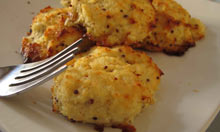 Dean & Deluca recipe crab cakes. Photograph: Felicity Cloake
Dean & Deluca recipe crab cakes. Photograph: Felicity Cloake Some recipes, like the Dean & Deluca and the Old Bay crabcakes, simply leave them uncoated, but this seems a shame ? a good crunchy crust provides a pleasing contrast to the soft crab meat inside. The National Cookbook and Rick Moonen use breadcrumbs (the latter my favourite panko variety), but again, this strays too close to fishcake territory for my liking. Beard's simple dredging of flour is less obtrusive, and works just as well in this case.
Cooking method
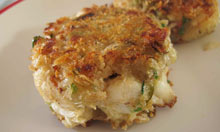 Rick Moonen recipe crab cakes. Photograph: Felicity Cloake
Rick Moonen recipe crab cakes. Photograph: Felicity Cloake Most crab cakes are, of course, fried. Many restaurants also offer them grilled these days, however, to cater for the more health-conscious diner, an option given on the Old Bay tin, and the Dean & Deluca recipe bakes and then grills them. The grilled, and baked and grilled versions, while nice enough flavourwise, lack the crisp crust of the fried variety, but shallow frying in ? inch oil, as suggested by the Saveur magazine recipe, seems unnecessary.
Although I find recipes calling for cooking in both butter and lard, and Mark Bittman goes for a mixture of butter and extra virgin olive oil, flavourless vegetable oil seems the best choice for keeping it simple.
Rick Moonen browns his on the outside, and then cooks them through in the oven, but he works in a restaurant where the ovens are presumably on already. Heating mine up for five minutes seems wasteful when I could just make the crabcakes thinner, and cook them through in the pan. After all, this is a dish you don't want to be waiting around for.
Perfect crab cakes
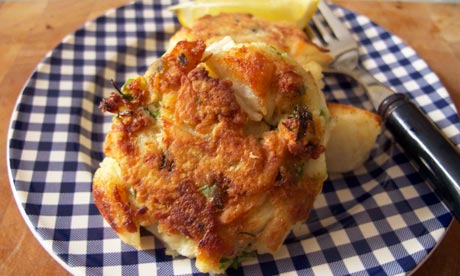 Felicity's perfect crab cakes. Photograph: Felicity Cloake
Felicity's perfect crab cakes. Photograph: Felicity Cloake Makes 4
40g breadcrumbs
? tsp mustard powder
? tsp salt
? tsp white pepper
Pinch of nutmeg
Pinch of paprika
2 tbsp parsley, chopped
250g white crabmeat, in chunks
1 egg, beaten
Flour, to coat
Vegetable oil, to cook
Lemon wedges, to serve
1. Put the breadcrumbs, mustard powder, seasoning and parsley in a bowl and stir well to combine. Add the crab and stir gently to distribute, being careful not to break up the chunks. Add the egg, a little at a time, until you have a firm mixture that you can form into cakes.
2. Divide into four, and shape into flat cakes. Put a little flour in a flat dish, season lightly and turn the fishcakes in it to coat. Chill for 30 minutes.
3. Coat the bottom of a frying pan with a shallow layer of oil and cook the crab cakes over a medium-high heat for about 4 minutes on each side, turning carefully, until crisp and golden. Serve immediately.
Does Maryland make the world's finest crab cakes or have they just got the best press? Do you prefer your crab straight from the shell, or are there other recipes which showcase its nippy charms better?
Source: http://www.guardian.co.uk/lifeandstyle/wordofmouth/2012/aug/23/how-cook-perfect-crab-cakes
mastectomy st. nicholas st. nicholas heisman finalists heisman finalists kepler 22 b kepler 22 b
No comments:
Post a Comment
Note: Only a member of this blog may post a comment.